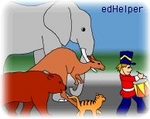
Worksheets and No Prep Teaching Resources
Reading Comprehension Worksheets
Animal Themes
Mammals
Oceans

Animal Themes
 Worksheets and No Prep Teaching Resources Reading Comprehension Worksheets Animal Themes Mammals Oceans |
 Animal Themes |
| edHelper's suggested reading level: | grades 5 to 7 | |
| Flesch-Kincaid grade level: | 6.37 |
| Print Whales (font options, pick words for additional puzzles, and more) |
| Quickly print reading comprehension |
| Print a proofreading activity |
| Whales |

|
 1 Have you ever been on a whale watching tour? Imagine it: after hours on a boat, you may grow bored and tired. Yet, as soon as you see a group of whales swimming nearby the boat, your spirit is uplifted, and you become excited. You watch these ocean giants closely. You don't want to shift your focus away for even a second, afraid that you may miss them breaching (leaping out of the water), spyhopping (poking their heads out of the water), or lobtailing (sticking their tails out of the water). In short, whale watching is an extremely rewarding and unforgettable experience! So, let's learn about whales!
1 Have you ever been on a whale watching tour? Imagine it: after hours on a boat, you may grow bored and tired. Yet, as soon as you see a group of whales swimming nearby the boat, your spirit is uplifted, and you become excited. You watch these ocean giants closely. You don't want to shift your focus away for even a second, afraid that you may miss them breaching (leaping out of the water), spyhopping (poking their heads out of the water), or lobtailing (sticking their tails out of the water). In short, whale watching is an extremely rewarding and unforgettable experience! So, let's learn about whales! |
Create Weekly Reading Books
Prepare for an entire week at once! |
| Leave your feedback on Whales (use this link if you found an error in the story) |
 |
Animal Themes
|
 |
Mammals
|
 |
Oceans
|
|
|